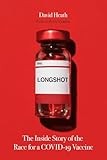Wim Hof, also known as the Iceman, is a Dutch superathlete who holds 21 Guinness World Records for cold exposure. He is known for the following:
- Running a half marathon above the Arctic Circle, barefoot only wearing shorts.
- Swimming underneath ice for 66 meters
- Hanging on one finger at an altitude of 2,000 meters
- Climbing the highest mountains in the world while wearing only shorts
- Running a full marathon in the Namib Desert without drinking
Wim Hof could do all of that thanks to the Wim Hof Method (WMF)he developed. The WMF consists of forced breathing, cold exposure, and meditation.
In the “Brain over Body” study, Wim Hof’s garment has tubes that alternately carry neutral temperature and freezing cold water. The suit simulated an icy environment and allowed the Iceman to be inside the functional Magnetic Resonance Imaging (fMRI) for brain imaging or a Positron Emission Tomography/Computerized Tomography PET/CT scan for body scans.

Functional Magnetic Resonance Imaging (fMRI) measured brain activities. PET/CT scan with tracers measured changes in sympathetic innervation (stress hormone/response pathway) and glucose consumption (a measure of cellular activity) in muscle and fat tissues. The study was conducted with the Iceman not doing and doing the WHM.
Results:
Pain Control
The Wim Hof Method made the periaqueductal gray of the brain send signals that work as pain killers or analgesics to decrease the amount of pain he perceives from the cold.
fMRI analyses indicated that the WHM activates primary control centers for descending pain/cold stimuli modulation in the (PAG), possibly initiating a stress-induced analgesic response.
The Wim Hof Method stimulated the brain’s left anterior insula and right middle insula to increase mental concentration and focus internally to decrease the pain sensation from the cold water.
In addition, the WHM also engages higher-order cortical areas (left anterior and right middle insula) that are uniquely associated with self-reflection, and which facilitate both internal focus and sustained attention in the presence of averse (e.g. cold) external stimuli.
Heat Generation
The intercostal muscles between the ribs contract hard during the Wim Hof Method, generating heat that transfers to the lungs and the blood circulatory system.
Finally, forceful respiration results in increased sympathetic innervation and glucose consumption in intercostal muscle, generating heat that dissipates to lung tissue and warms circulating blood in the pulmonary capillaries.
The drawing below shows the intercostal muscles in red between the ribs in white.

In summary, the Wim Hof method stimulates the brain to reduce the perceived pain from the cold. It generates heat from the intercostal muscles to warm the body while the Iceman is under freezing temperatures.
Learn more about the Wim Hof Method at this LINK.
There is more to the Wim Hof Method than tolerating cold. It can modulate the immune system to control autoimmune diseases.
You may also like:
- Secrets of the Ice Man: Voluntary control of adrenaline and the effect on the immune system.
- The beneficial effects of the Wim Hof Method on arthritis
- 30 Ways For a Good Sleep Without Drugs
- How Does Sleeping Protect the Brain?
- 25 Stress-Reduction Techniques
- What is Insulin Resistance?
- The Magical Endothelium
- 8 Ways Decent Dental Care Defies Dementia
- How to be Active from Sedentary
- 21 Benefits of High-Intensity Interval Training
- How to Do Intermittent Fasting
- Early Time-Restricted Feeding is Intermittent Fasting In Sync with the Circadian Rhythm
- The Game-Changing Uses of K.A.A.T.S.U.
Knowledge about Covid-19 is rapidly evolving. Stay current by subscribing. Feel free to share and like.
If you find value in the articles, please consider donating to show your support.
Reference:
Muzik O, Reilly KT, Diwadkar VA. “Brain over body”-A study on the willful regulation of autonomic function during cold exposure. Neuroimage. 2018 May 15;172:632-641. doi: 10.1016/j.neuroimage.2018.01.067. Epub 2018 Feb 10. PMID: 29438845.
© 2018 – 2022 Asclepiades Medicine, L.L.C. All Rights Reserved
DrJesseSantiano.com does not provide medical advice, diagnosis, or treatment
As an Amazon Associate, I earn from qualifying purchases.
Longshot: The Inside Story of the Race for a COVID-19 Vaccine
72% OffCovid-19 Unmasked: The News, The Science, And Common Sense
67% OffCommunicating COVID-19: Media, Trust, and Public Engagement
22% OffPandemic Politics: The Deadly Toll of Partisanship in the Age of COVID
55% OffIndonesian and Philippine Media on China and COVID-19 (COVID-19 in Asia)
Discover more from Don't Get Sick!
Subscribe to get the latest posts sent to your email.




